Strategic Management and Information Systems: Examples and Impacts
VerifiedAdded on 2023/06/10
|13
|3261
|380
Report
AI Summary
This report delves into the realm of Strategic Management and Information Systems, examining the core concepts and their practical applications. It begins by defining Information Systems and highlighting their significance in the modern business landscape. The report then showcases various innovations, including the Internet of Things (IoT), Artificial Intelligence (AI), Medical Innovations, and Virtual Reality, providing detailed examples and illustrations. It further explores the successes and failures associated with these innovations, particularly focusing on the risks involved with AI and the impacts of IoT, medical advancements, and virtual reality. The analysis extends to the internal factors influencing the success of information systems, encompassing organizational, individual, and management aspects, and also considers the external factors such as technological, environmental, and political influences. Finally, the report concludes with strategic recommendations for firms, emphasizing the importance of a phased IT implementation approach. The report aims to offer a comprehensive understanding of the strategic importance of information systems and how businesses can leverage them for success. This report is available on Desklib, a platform offering resources for students.
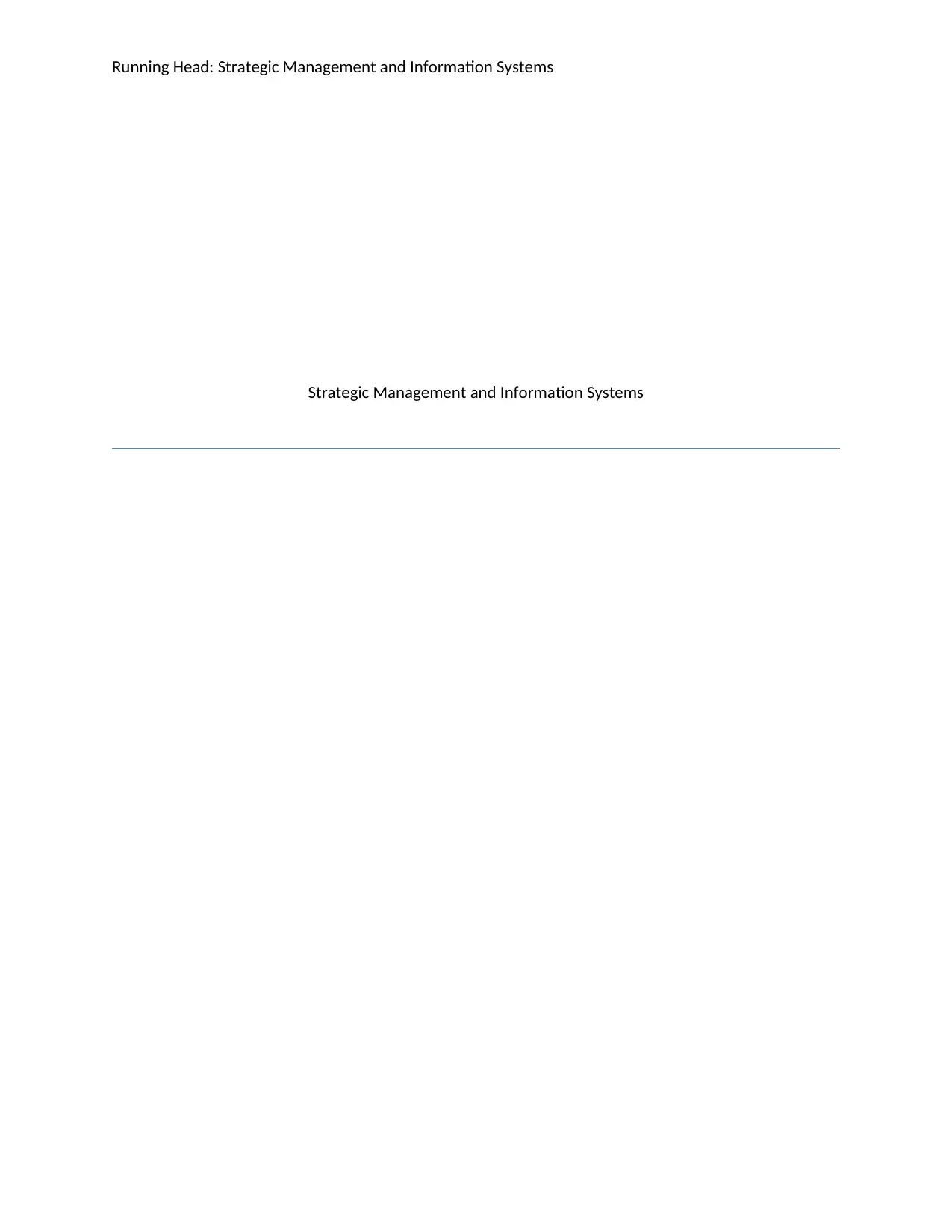
Running Head: Strategic Management and Information Systems
Strategic Management and Information Systems
Strategic Management and Information Systems
Secure Best Marks with AI Grader
Need help grading? Try our AI Grader for instant feedback on your assignments.
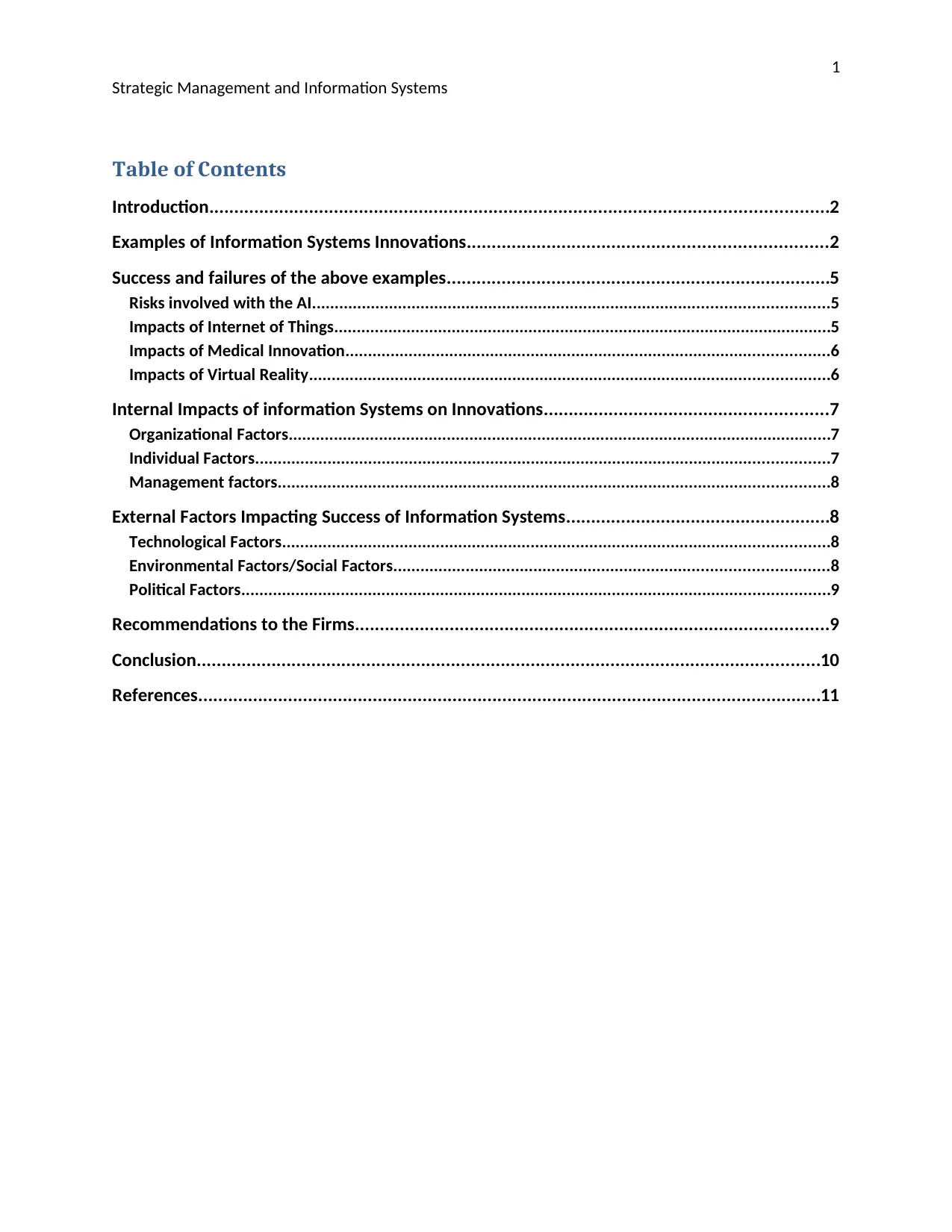
1
Strategic Management and Information Systems
Table of Contents
Introduction............................................................................................................................2
Examples of Information Systems Innovations........................................................................2
Success and failures of the above examples.............................................................................5
Risks involved with the AI..................................................................................................................5
Impacts of Internet of Things..............................................................................................................5
Impacts of Medical Innovation...........................................................................................................6
Impacts of Virtual Reality...................................................................................................................6
Internal Impacts of information Systems on Innovations.........................................................7
Organizational Factors........................................................................................................................7
Individual Factors...............................................................................................................................7
Management factors..........................................................................................................................8
External Factors Impacting Success of Information Systems.....................................................8
Technological Factors.........................................................................................................................8
Environmental Factors/Social Factors................................................................................................8
Political Factors..................................................................................................................................9
Recommendations to the Firms...............................................................................................9
Conclusion.............................................................................................................................10
References.............................................................................................................................11
Strategic Management and Information Systems
Table of Contents
Introduction............................................................................................................................2
Examples of Information Systems Innovations........................................................................2
Success and failures of the above examples.............................................................................5
Risks involved with the AI..................................................................................................................5
Impacts of Internet of Things..............................................................................................................5
Impacts of Medical Innovation...........................................................................................................6
Impacts of Virtual Reality...................................................................................................................6
Internal Impacts of information Systems on Innovations.........................................................7
Organizational Factors........................................................................................................................7
Individual Factors...............................................................................................................................7
Management factors..........................................................................................................................8
External Factors Impacting Success of Information Systems.....................................................8
Technological Factors.........................................................................................................................8
Environmental Factors/Social Factors................................................................................................8
Political Factors..................................................................................................................................9
Recommendations to the Firms...............................................................................................9
Conclusion.............................................................................................................................10
References.............................................................................................................................11
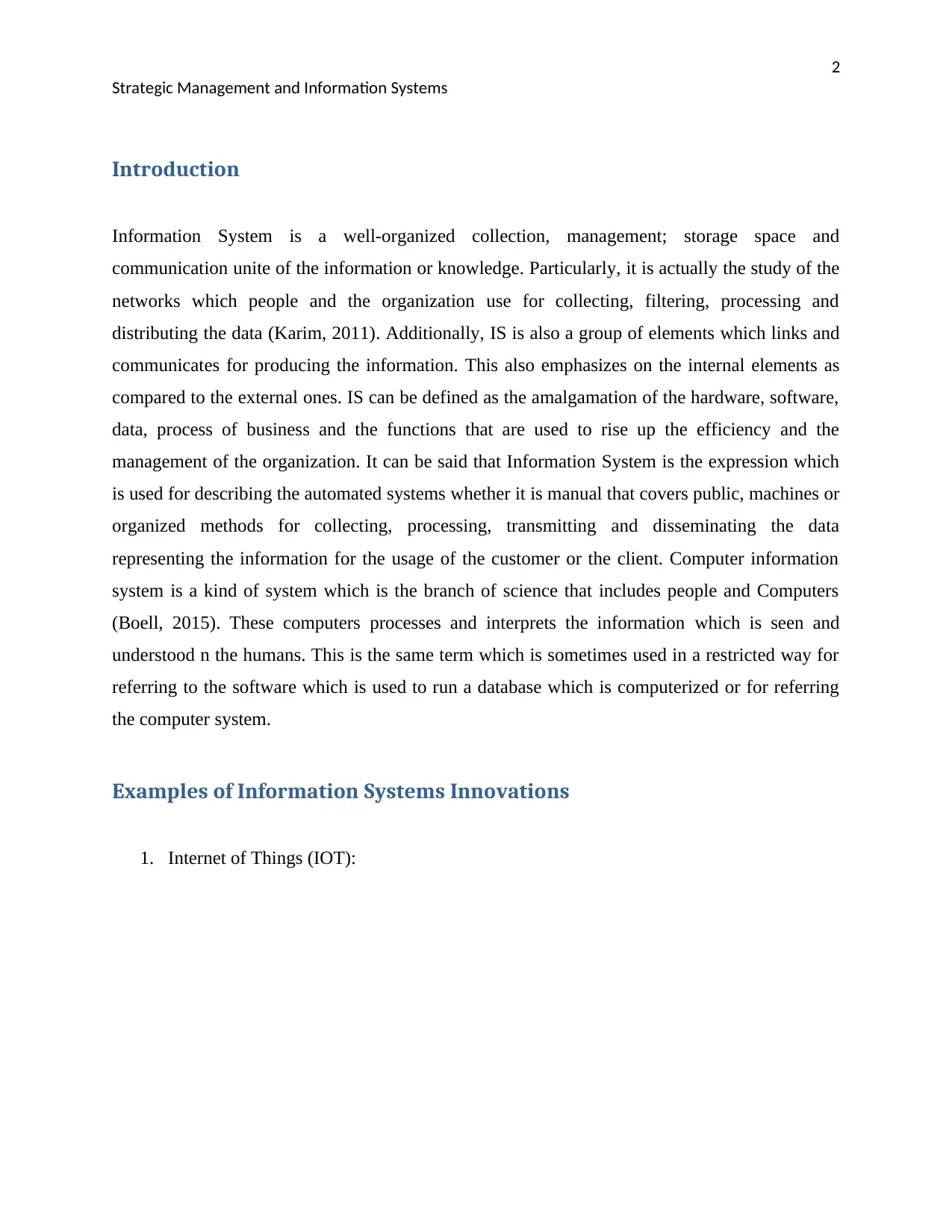
2
Strategic Management and Information Systems
Introduction
Information System is a well-organized collection, management; storage space and
communication unite of the information or knowledge. Particularly, it is actually the study of the
networks which people and the organization use for collecting, filtering, processing and
distributing the data (Karim, 2011). Additionally, IS is also a group of elements which links and
communicates for producing the information. This also emphasizes on the internal elements as
compared to the external ones. IS can be defined as the amalgamation of the hardware, software,
data, process of business and the functions that are used to rise up the efficiency and the
management of the organization. It can be said that Information System is the expression which
is used for describing the automated systems whether it is manual that covers public, machines or
organized methods for collecting, processing, transmitting and disseminating the data
representing the information for the usage of the customer or the client. Computer information
system is a kind of system which is the branch of science that includes people and Computers
(Boell, 2015). These computers processes and interprets the information which is seen and
understood n the humans. This is the same term which is sometimes used in a restricted way for
referring to the software which is used to run a database which is computerized or for referring
the computer system.
Examples of Information Systems Innovations
1. Internet of Things (IOT):
Strategic Management and Information Systems
Introduction
Information System is a well-organized collection, management; storage space and
communication unite of the information or knowledge. Particularly, it is actually the study of the
networks which people and the organization use for collecting, filtering, processing and
distributing the data (Karim, 2011). Additionally, IS is also a group of elements which links and
communicates for producing the information. This also emphasizes on the internal elements as
compared to the external ones. IS can be defined as the amalgamation of the hardware, software,
data, process of business and the functions that are used to rise up the efficiency and the
management of the organization. It can be said that Information System is the expression which
is used for describing the automated systems whether it is manual that covers public, machines or
organized methods for collecting, processing, transmitting and disseminating the data
representing the information for the usage of the customer or the client. Computer information
system is a kind of system which is the branch of science that includes people and Computers
(Boell, 2015). These computers processes and interprets the information which is seen and
understood n the humans. This is the same term which is sometimes used in a restricted way for
referring to the software which is used to run a database which is computerized or for referring
the computer system.
Examples of Information Systems Innovations
1. Internet of Things (IOT):
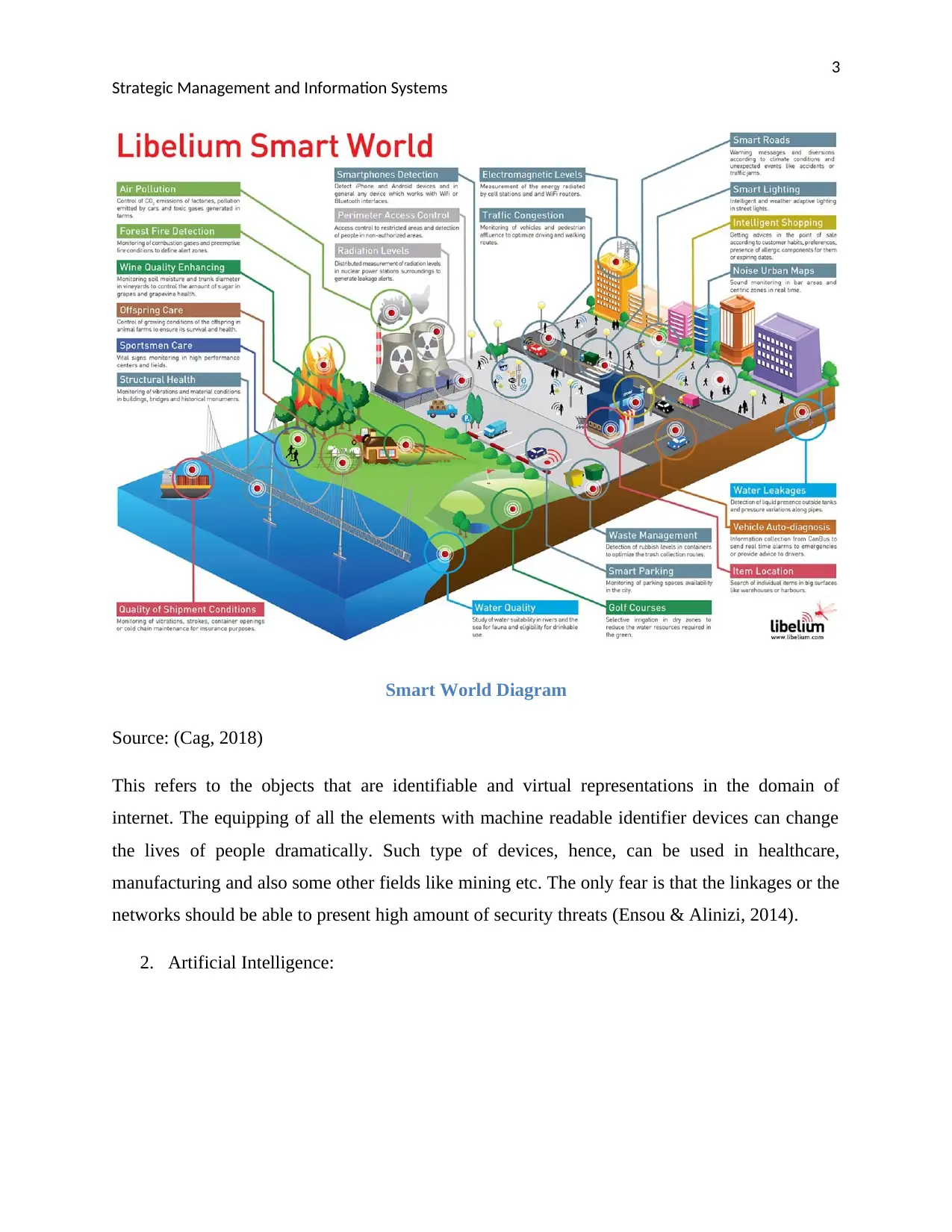
3
Strategic Management and Information Systems
Smart World Diagram
Source: (Cag, 2018)
This refers to the objects that are identifiable and virtual representations in the domain of
internet. The equipping of all the elements with machine readable identifier devices can change
the lives of people dramatically. Such type of devices, hence, can be used in healthcare,
manufacturing and also some other fields like mining etc. The only fear is that the linkages or the
networks should be able to present high amount of security threats (Ensou & Alinizi, 2014).
2. Artificial Intelligence:
Strategic Management and Information Systems
Smart World Diagram
Source: (Cag, 2018)
This refers to the objects that are identifiable and virtual representations in the domain of
internet. The equipping of all the elements with machine readable identifier devices can change
the lives of people dramatically. Such type of devices, hence, can be used in healthcare,
manufacturing and also some other fields like mining etc. The only fear is that the linkages or the
networks should be able to present high amount of security threats (Ensou & Alinizi, 2014).
2. Artificial Intelligence:
Secure Best Marks with AI Grader
Need help grading? Try our AI Grader for instant feedback on your assignments.
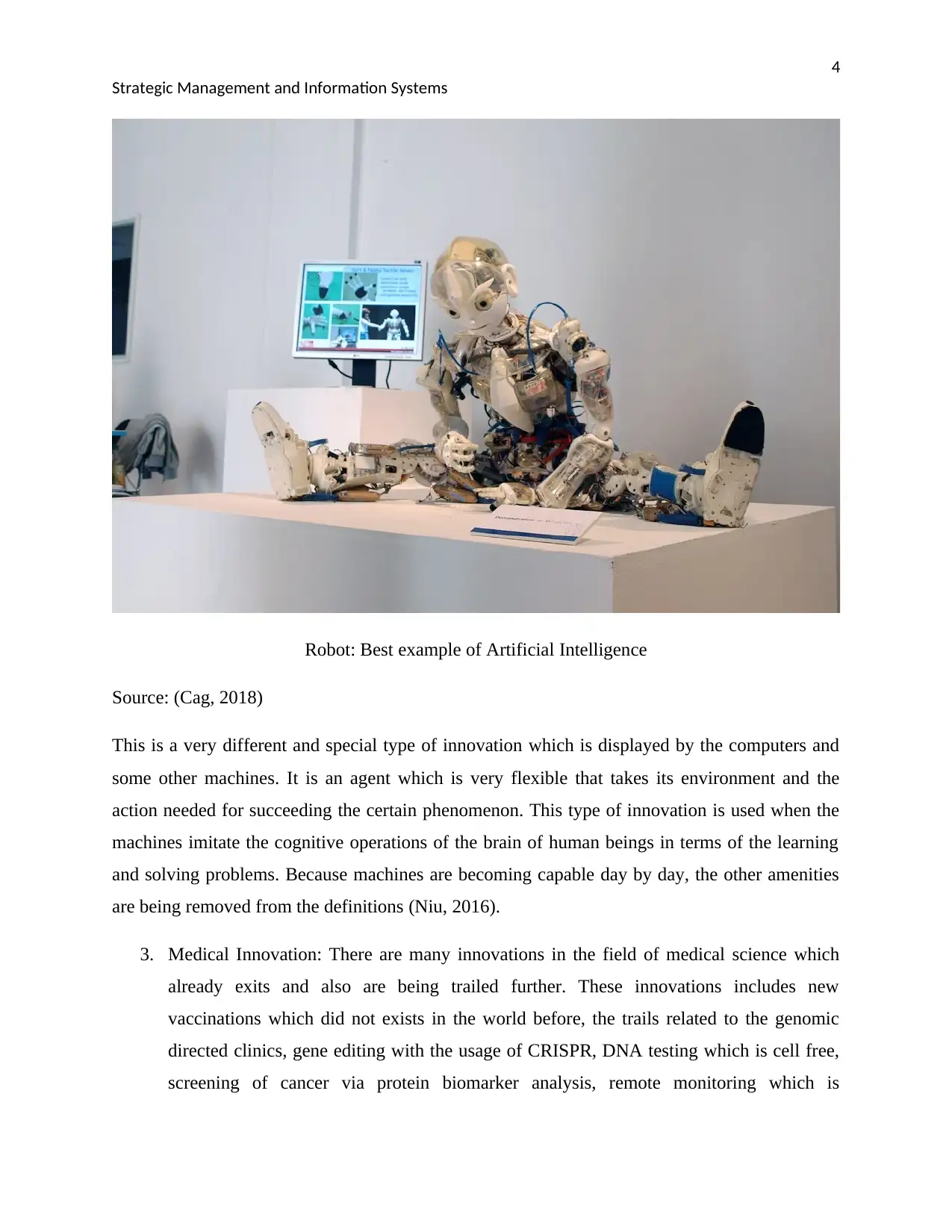
4
Strategic Management and Information Systems
Robot: Best example of Artificial Intelligence
Source: (Cag, 2018)
This is a very different and special type of innovation which is displayed by the computers and
some other machines. It is an agent which is very flexible that takes its environment and the
action needed for succeeding the certain phenomenon. This type of innovation is used when the
machines imitate the cognitive operations of the brain of human beings in terms of the learning
and solving problems. Because machines are becoming capable day by day, the other amenities
are being removed from the definitions (Niu, 2016).
3. Medical Innovation: There are many innovations in the field of medical science which
already exits and also are being trailed further. These innovations includes new
vaccinations which did not exists in the world before, the trails related to the genomic
directed clinics, gene editing with the usage of CRISPR, DNA testing which is cell free,
screening of cancer via protein biomarker analysis, remote monitoring which is
Strategic Management and Information Systems
Robot: Best example of Artificial Intelligence
Source: (Cag, 2018)
This is a very different and special type of innovation which is displayed by the computers and
some other machines. It is an agent which is very flexible that takes its environment and the
action needed for succeeding the certain phenomenon. This type of innovation is used when the
machines imitate the cognitive operations of the brain of human beings in terms of the learning
and solving problems. Because machines are becoming capable day by day, the other amenities
are being removed from the definitions (Niu, 2016).
3. Medical Innovation: There are many innovations in the field of medical science which
already exits and also are being trailed further. These innovations includes new
vaccinations which did not exists in the world before, the trails related to the genomic
directed clinics, gene editing with the usage of CRISPR, DNA testing which is cell free,
screening of cancer via protein biomarker analysis, remote monitoring which is
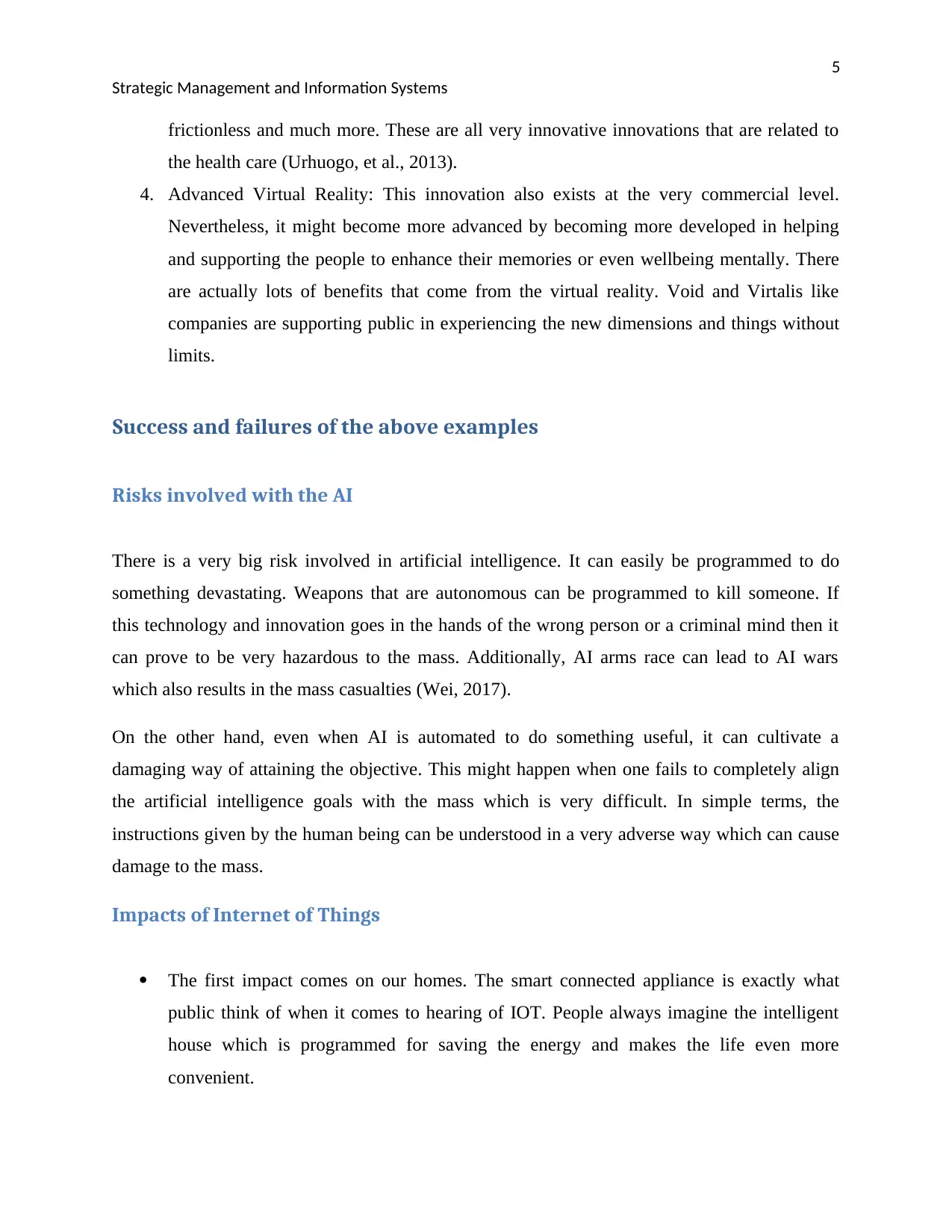
5
Strategic Management and Information Systems
frictionless and much more. These are all very innovative innovations that are related to
the health care (Urhuogo, et al., 2013).
4. Advanced Virtual Reality: This innovation also exists at the very commercial level.
Nevertheless, it might become more advanced by becoming more developed in helping
and supporting the people to enhance their memories or even wellbeing mentally. There
are actually lots of benefits that come from the virtual reality. Void and Virtalis like
companies are supporting public in experiencing the new dimensions and things without
limits.
Success and failures of the above examples
Risks involved with the AI
There is a very big risk involved in artificial intelligence. It can easily be programmed to do
something devastating. Weapons that are autonomous can be programmed to kill someone. If
this technology and innovation goes in the hands of the wrong person or a criminal mind then it
can prove to be very hazardous to the mass. Additionally, AI arms race can lead to AI wars
which also results in the mass casualties (Wei, 2017).
On the other hand, even when AI is automated to do something useful, it can cultivate a
damaging way of attaining the objective. This might happen when one fails to completely align
the artificial intelligence goals with the mass which is very difficult. In simple terms, the
instructions given by the human being can be understood in a very adverse way which can cause
damage to the mass.
Impacts of Internet of Things
The first impact comes on our homes. The smart connected appliance is exactly what
public think of when it comes to hearing of IOT. People always imagine the intelligent
house which is programmed for saving the energy and makes the life even more
convenient.
Strategic Management and Information Systems
frictionless and much more. These are all very innovative innovations that are related to
the health care (Urhuogo, et al., 2013).
4. Advanced Virtual Reality: This innovation also exists at the very commercial level.
Nevertheless, it might become more advanced by becoming more developed in helping
and supporting the people to enhance their memories or even wellbeing mentally. There
are actually lots of benefits that come from the virtual reality. Void and Virtalis like
companies are supporting public in experiencing the new dimensions and things without
limits.
Success and failures of the above examples
Risks involved with the AI
There is a very big risk involved in artificial intelligence. It can easily be programmed to do
something devastating. Weapons that are autonomous can be programmed to kill someone. If
this technology and innovation goes in the hands of the wrong person or a criminal mind then it
can prove to be very hazardous to the mass. Additionally, AI arms race can lead to AI wars
which also results in the mass casualties (Wei, 2017).
On the other hand, even when AI is automated to do something useful, it can cultivate a
damaging way of attaining the objective. This might happen when one fails to completely align
the artificial intelligence goals with the mass which is very difficult. In simple terms, the
instructions given by the human being can be understood in a very adverse way which can cause
damage to the mass.
Impacts of Internet of Things
The first impact comes on our homes. The smart connected appliance is exactly what
public think of when it comes to hearing of IOT. People always imagine the intelligent
house which is programmed for saving the energy and makes the life even more
convenient.
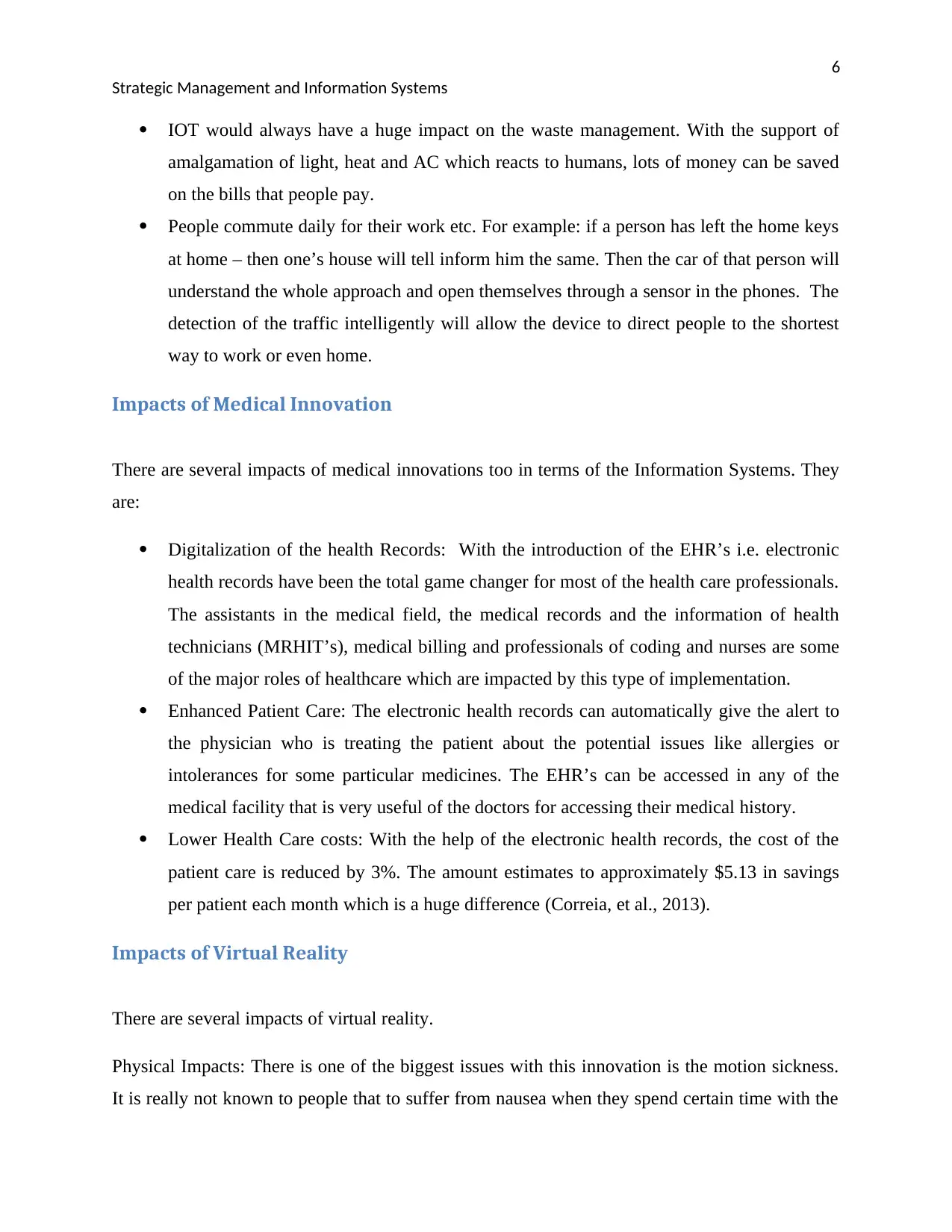
6
Strategic Management and Information Systems
IOT would always have a huge impact on the waste management. With the support of
amalgamation of light, heat and AC which reacts to humans, lots of money can be saved
on the bills that people pay.
People commute daily for their work etc. For example: if a person has left the home keys
at home – then one’s house will tell inform him the same. Then the car of that person will
understand the whole approach and open themselves through a sensor in the phones. The
detection of the traffic intelligently will allow the device to direct people to the shortest
way to work or even home.
Impacts of Medical Innovation
There are several impacts of medical innovations too in terms of the Information Systems. They
are:
Digitalization of the health Records: With the introduction of the EHR’s i.e. electronic
health records have been the total game changer for most of the health care professionals.
The assistants in the medical field, the medical records and the information of health
technicians (MRHIT’s), medical billing and professionals of coding and nurses are some
of the major roles of healthcare which are impacted by this type of implementation.
Enhanced Patient Care: The electronic health records can automatically give the alert to
the physician who is treating the patient about the potential issues like allergies or
intolerances for some particular medicines. The EHR’s can be accessed in any of the
medical facility that is very useful of the doctors for accessing their medical history.
Lower Health Care costs: With the help of the electronic health records, the cost of the
patient care is reduced by 3%. The amount estimates to approximately $5.13 in savings
per patient each month which is a huge difference (Correia, et al., 2013).
Impacts of Virtual Reality
There are several impacts of virtual reality.
Physical Impacts: There is one of the biggest issues with this innovation is the motion sickness.
It is really not known to people that to suffer from nausea when they spend certain time with the
Strategic Management and Information Systems
IOT would always have a huge impact on the waste management. With the support of
amalgamation of light, heat and AC which reacts to humans, lots of money can be saved
on the bills that people pay.
People commute daily for their work etc. For example: if a person has left the home keys
at home – then one’s house will tell inform him the same. Then the car of that person will
understand the whole approach and open themselves through a sensor in the phones. The
detection of the traffic intelligently will allow the device to direct people to the shortest
way to work or even home.
Impacts of Medical Innovation
There are several impacts of medical innovations too in terms of the Information Systems. They
are:
Digitalization of the health Records: With the introduction of the EHR’s i.e. electronic
health records have been the total game changer for most of the health care professionals.
The assistants in the medical field, the medical records and the information of health
technicians (MRHIT’s), medical billing and professionals of coding and nurses are some
of the major roles of healthcare which are impacted by this type of implementation.
Enhanced Patient Care: The electronic health records can automatically give the alert to
the physician who is treating the patient about the potential issues like allergies or
intolerances for some particular medicines. The EHR’s can be accessed in any of the
medical facility that is very useful of the doctors for accessing their medical history.
Lower Health Care costs: With the help of the electronic health records, the cost of the
patient care is reduced by 3%. The amount estimates to approximately $5.13 in savings
per patient each month which is a huge difference (Correia, et al., 2013).
Impacts of Virtual Reality
There are several impacts of virtual reality.
Physical Impacts: There is one of the biggest issues with this innovation is the motion sickness.
It is really not known to people that to suffer from nausea when they spend certain time with the
Paraphrase This Document
Need a fresh take? Get an instant paraphrase of this document with our AI Paraphraser
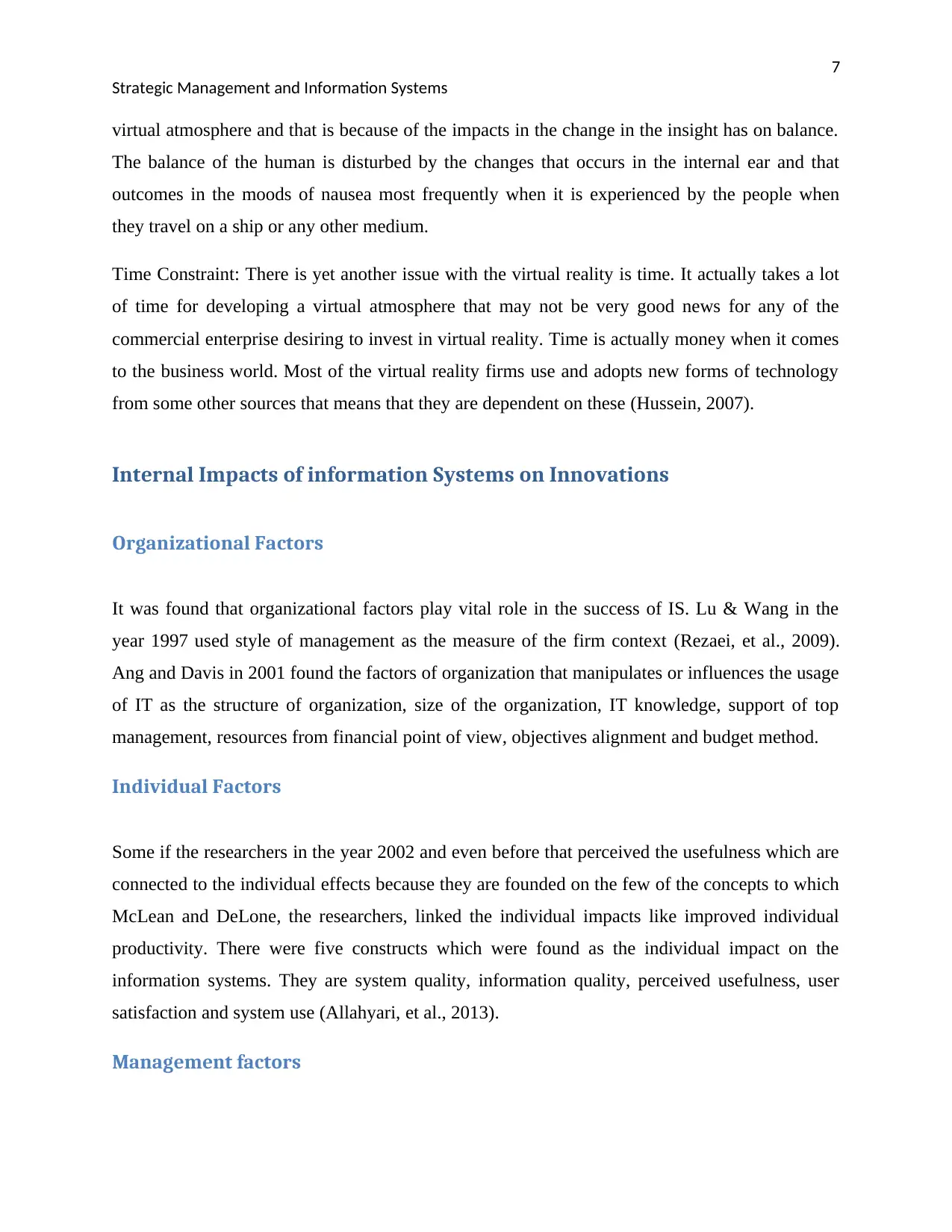
7
Strategic Management and Information Systems
virtual atmosphere and that is because of the impacts in the change in the insight has on balance.
The balance of the human is disturbed by the changes that occurs in the internal ear and that
outcomes in the moods of nausea most frequently when it is experienced by the people when
they travel on a ship or any other medium.
Time Constraint: There is yet another issue with the virtual reality is time. It actually takes a lot
of time for developing a virtual atmosphere that may not be very good news for any of the
commercial enterprise desiring to invest in virtual reality. Time is actually money when it comes
to the business world. Most of the virtual reality firms use and adopts new forms of technology
from some other sources that means that they are dependent on these (Hussein, 2007).
Internal Impacts of information Systems on Innovations
Organizational Factors
It was found that organizational factors play vital role in the success of IS. Lu & Wang in the
year 1997 used style of management as the measure of the firm context (Rezaei, et al., 2009).
Ang and Davis in 2001 found the factors of organization that manipulates or influences the usage
of IT as the structure of organization, size of the organization, IT knowledge, support of top
management, resources from financial point of view, objectives alignment and budget method.
Individual Factors
Some if the researchers in the year 2002 and even before that perceived the usefulness which are
connected to the individual effects because they are founded on the few of the concepts to which
McLean and DeLone, the researchers, linked the individual impacts like improved individual
productivity. There were five constructs which were found as the individual impact on the
information systems. They are system quality, information quality, perceived usefulness, user
satisfaction and system use (Allahyari, et al., 2013).
Management factors
Strategic Management and Information Systems
virtual atmosphere and that is because of the impacts in the change in the insight has on balance.
The balance of the human is disturbed by the changes that occurs in the internal ear and that
outcomes in the moods of nausea most frequently when it is experienced by the people when
they travel on a ship or any other medium.
Time Constraint: There is yet another issue with the virtual reality is time. It actually takes a lot
of time for developing a virtual atmosphere that may not be very good news for any of the
commercial enterprise desiring to invest in virtual reality. Time is actually money when it comes
to the business world. Most of the virtual reality firms use and adopts new forms of technology
from some other sources that means that they are dependent on these (Hussein, 2007).
Internal Impacts of information Systems on Innovations
Organizational Factors
It was found that organizational factors play vital role in the success of IS. Lu & Wang in the
year 1997 used style of management as the measure of the firm context (Rezaei, et al., 2009).
Ang and Davis in 2001 found the factors of organization that manipulates or influences the usage
of IT as the structure of organization, size of the organization, IT knowledge, support of top
management, resources from financial point of view, objectives alignment and budget method.
Individual Factors
Some if the researchers in the year 2002 and even before that perceived the usefulness which are
connected to the individual effects because they are founded on the few of the concepts to which
McLean and DeLone, the researchers, linked the individual impacts like improved individual
productivity. There were five constructs which were found as the individual impact on the
information systems. They are system quality, information quality, perceived usefulness, user
satisfaction and system use (Allahyari, et al., 2013).
Management factors
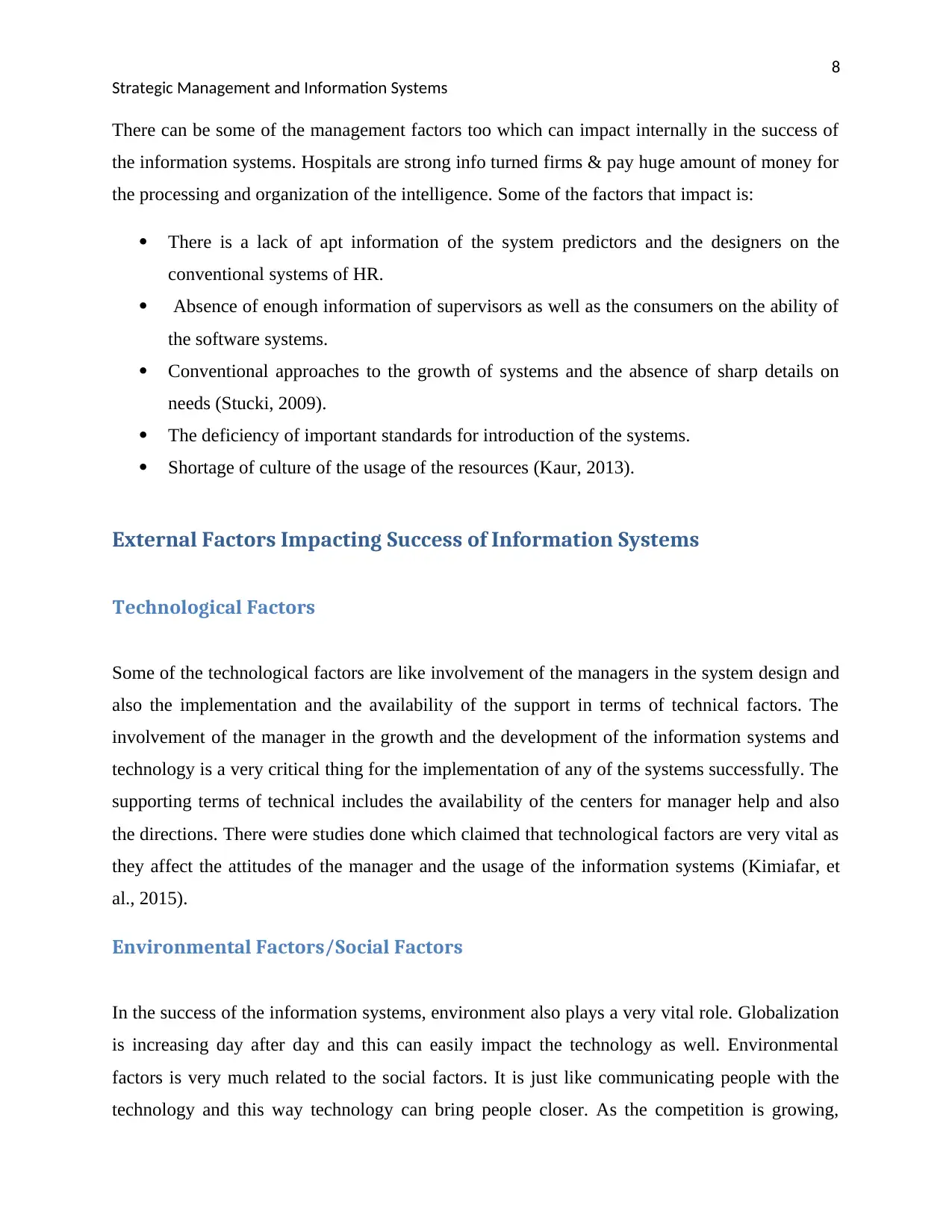
8
Strategic Management and Information Systems
There can be some of the management factors too which can impact internally in the success of
the information systems. Hospitals are strong info turned firms & pay huge amount of money for
the processing and organization of the intelligence. Some of the factors that impact is:
There is a lack of apt information of the system predictors and the designers on the
conventional systems of HR.
Absence of enough information of supervisors as well as the consumers on the ability of
the software systems.
Conventional approaches to the growth of systems and the absence of sharp details on
needs (Stucki, 2009).
The deficiency of important standards for introduction of the systems.
Shortage of culture of the usage of the resources (Kaur, 2013).
External Factors Impacting Success of Information Systems
Technological Factors
Some of the technological factors are like involvement of the managers in the system design and
also the implementation and the availability of the support in terms of technical factors. The
involvement of the manager in the growth and the development of the information systems and
technology is a very critical thing for the implementation of any of the systems successfully. The
supporting terms of technical includes the availability of the centers for manager help and also
the directions. There were studies done which claimed that technological factors are very vital as
they affect the attitudes of the manager and the usage of the information systems (Kimiafar, et
al., 2015).
Environmental Factors/Social Factors
In the success of the information systems, environment also plays a very vital role. Globalization
is increasing day after day and this can easily impact the technology as well. Environmental
factors is very much related to the social factors. It is just like communicating people with the
technology and this way technology can bring people closer. As the competition is growing,
Strategic Management and Information Systems
There can be some of the management factors too which can impact internally in the success of
the information systems. Hospitals are strong info turned firms & pay huge amount of money for
the processing and organization of the intelligence. Some of the factors that impact is:
There is a lack of apt information of the system predictors and the designers on the
conventional systems of HR.
Absence of enough information of supervisors as well as the consumers on the ability of
the software systems.
Conventional approaches to the growth of systems and the absence of sharp details on
needs (Stucki, 2009).
The deficiency of important standards for introduction of the systems.
Shortage of culture of the usage of the resources (Kaur, 2013).
External Factors Impacting Success of Information Systems
Technological Factors
Some of the technological factors are like involvement of the managers in the system design and
also the implementation and the availability of the support in terms of technical factors. The
involvement of the manager in the growth and the development of the information systems and
technology is a very critical thing for the implementation of any of the systems successfully. The
supporting terms of technical includes the availability of the centers for manager help and also
the directions. There were studies done which claimed that technological factors are very vital as
they affect the attitudes of the manager and the usage of the information systems (Kimiafar, et
al., 2015).
Environmental Factors/Social Factors
In the success of the information systems, environment also plays a very vital role. Globalization
is increasing day after day and this can easily impact the technology as well. Environmental
factors is very much related to the social factors. It is just like communicating people with the
technology and this way technology can bring people closer. As the competition is growing,
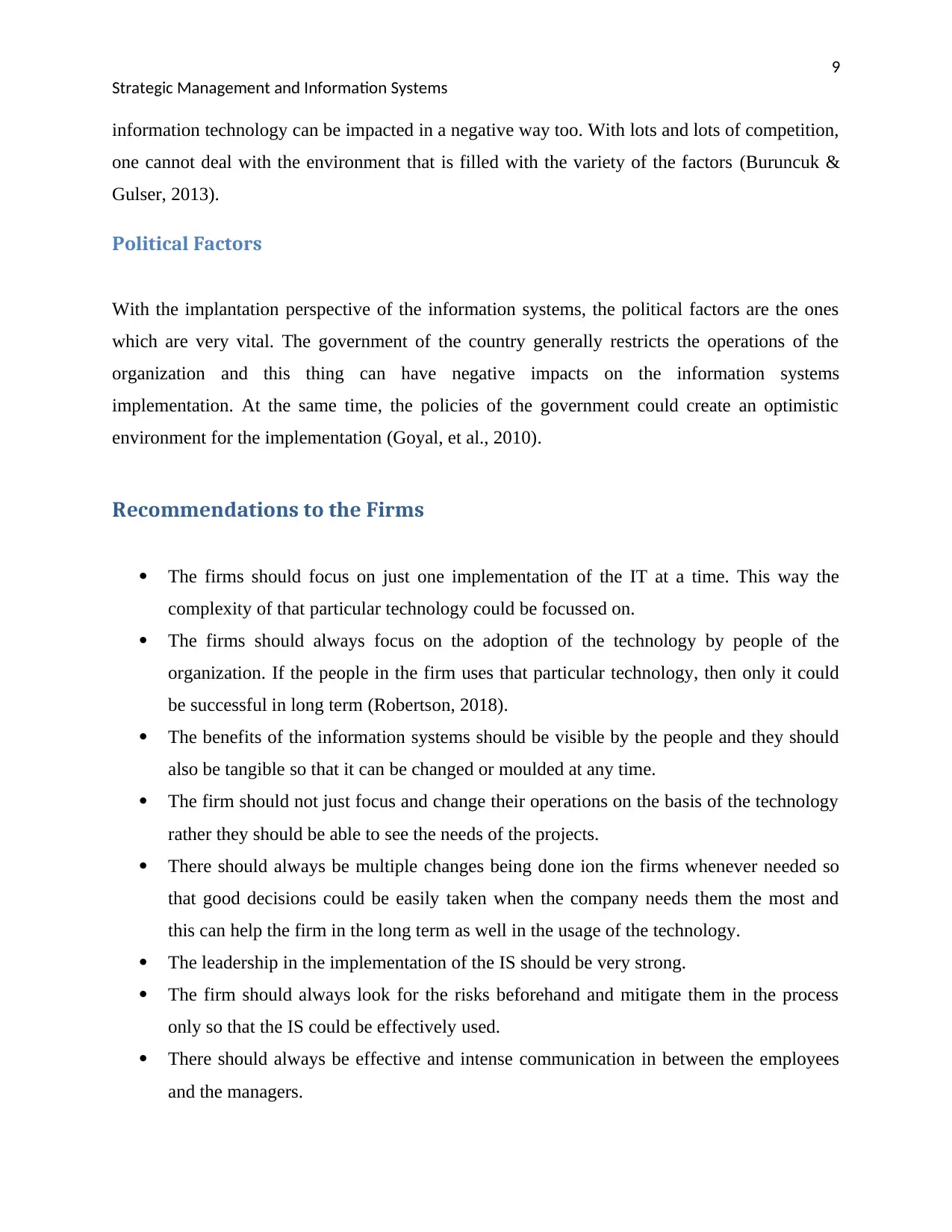
9
Strategic Management and Information Systems
information technology can be impacted in a negative way too. With lots and lots of competition,
one cannot deal with the environment that is filled with the variety of the factors (Buruncuk &
Gulser, 2013).
Political Factors
With the implantation perspective of the information systems, the political factors are the ones
which are very vital. The government of the country generally restricts the operations of the
organization and this thing can have negative impacts on the information systems
implementation. At the same time, the policies of the government could create an optimistic
environment for the implementation (Goyal, et al., 2010).
Recommendations to the Firms
The firms should focus on just one implementation of the IT at a time. This way the
complexity of that particular technology could be focussed on.
The firms should always focus on the adoption of the technology by people of the
organization. If the people in the firm uses that particular technology, then only it could
be successful in long term (Robertson, 2018).
The benefits of the information systems should be visible by the people and they should
also be tangible so that it can be changed or moulded at any time.
The firm should not just focus and change their operations on the basis of the technology
rather they should be able to see the needs of the projects.
There should always be multiple changes being done ion the firms whenever needed so
that good decisions could be easily taken when the company needs them the most and
this can help the firm in the long term as well in the usage of the technology.
The leadership in the implementation of the IS should be very strong.
The firm should always look for the risks beforehand and mitigate them in the process
only so that the IS could be effectively used.
There should always be effective and intense communication in between the employees
and the managers.
Strategic Management and Information Systems
information technology can be impacted in a negative way too. With lots and lots of competition,
one cannot deal with the environment that is filled with the variety of the factors (Buruncuk &
Gulser, 2013).
Political Factors
With the implantation perspective of the information systems, the political factors are the ones
which are very vital. The government of the country generally restricts the operations of the
organization and this thing can have negative impacts on the information systems
implementation. At the same time, the policies of the government could create an optimistic
environment for the implementation (Goyal, et al., 2010).
Recommendations to the Firms
The firms should focus on just one implementation of the IT at a time. This way the
complexity of that particular technology could be focussed on.
The firms should always focus on the adoption of the technology by people of the
organization. If the people in the firm uses that particular technology, then only it could
be successful in long term (Robertson, 2018).
The benefits of the information systems should be visible by the people and they should
also be tangible so that it can be changed or moulded at any time.
The firm should not just focus and change their operations on the basis of the technology
rather they should be able to see the needs of the projects.
There should always be multiple changes being done ion the firms whenever needed so
that good decisions could be easily taken when the company needs them the most and
this can help the firm in the long term as well in the usage of the technology.
The leadership in the implementation of the IS should be very strong.
The firm should always look for the risks beforehand and mitigate them in the process
only so that the IS could be effectively used.
There should always be effective and intense communication in between the employees
and the managers.
Secure Best Marks with AI Grader
Need help grading? Try our AI Grader for instant feedback on your assignments.
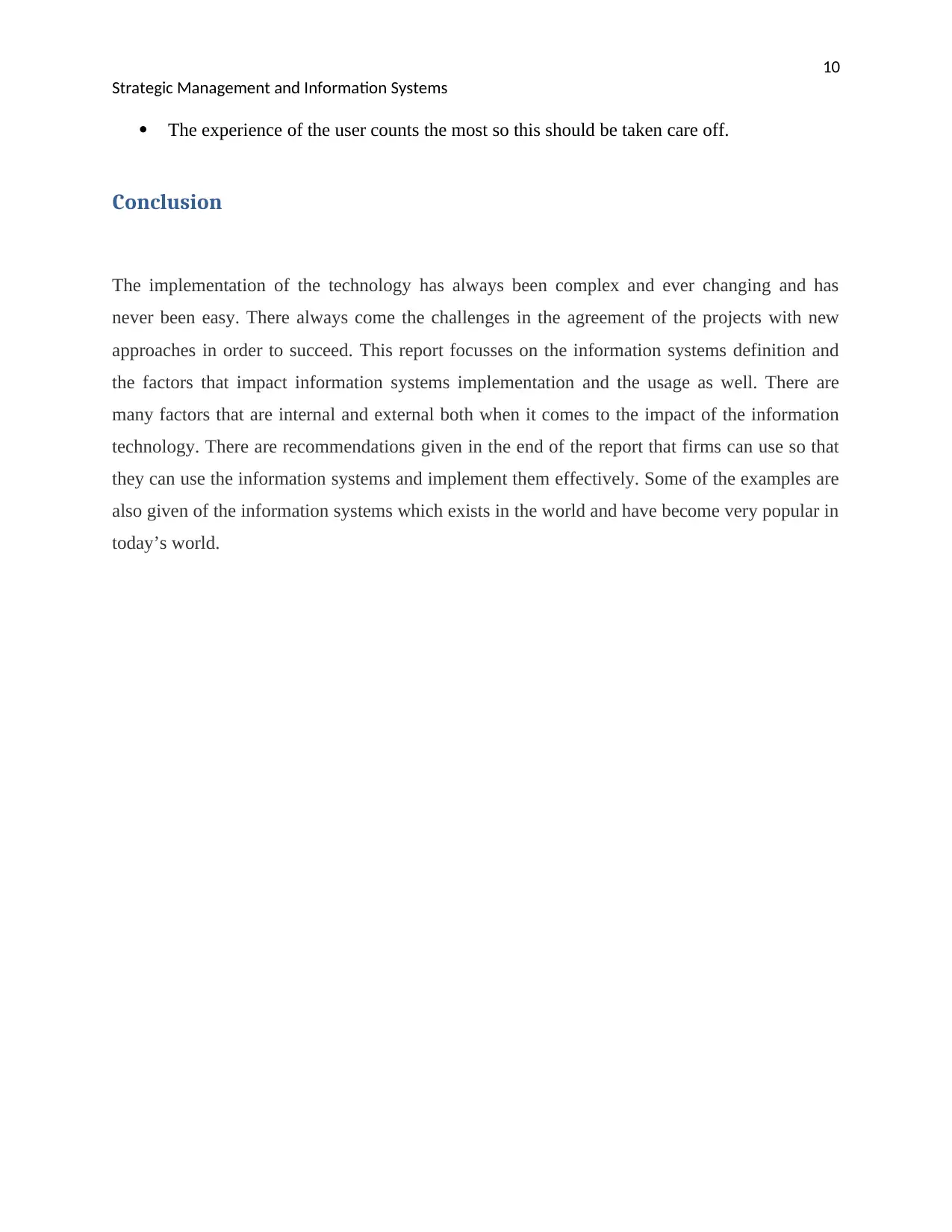
10
Strategic Management and Information Systems
The experience of the user counts the most so this should be taken care off.
Conclusion
The implementation of the technology has always been complex and ever changing and has
never been easy. There always come the challenges in the agreement of the projects with new
approaches in order to succeed. This report focusses on the information systems definition and
the factors that impact information systems implementation and the usage as well. There are
many factors that are internal and external both when it comes to the impact of the information
technology. There are recommendations given in the end of the report that firms can use so that
they can use the information systems and implement them effectively. Some of the examples are
also given of the information systems which exists in the world and have become very popular in
today’s world.
Strategic Management and Information Systems
The experience of the user counts the most so this should be taken care off.
Conclusion
The implementation of the technology has always been complex and ever changing and has
never been easy. There always come the challenges in the agreement of the projects with new
approaches in order to succeed. This report focusses on the information systems definition and
the factors that impact information systems implementation and the usage as well. There are
many factors that are internal and external both when it comes to the impact of the information
technology. There are recommendations given in the end of the report that firms can use so that
they can use the information systems and implement them effectively. Some of the examples are
also given of the information systems which exists in the world and have become very popular in
today’s world.
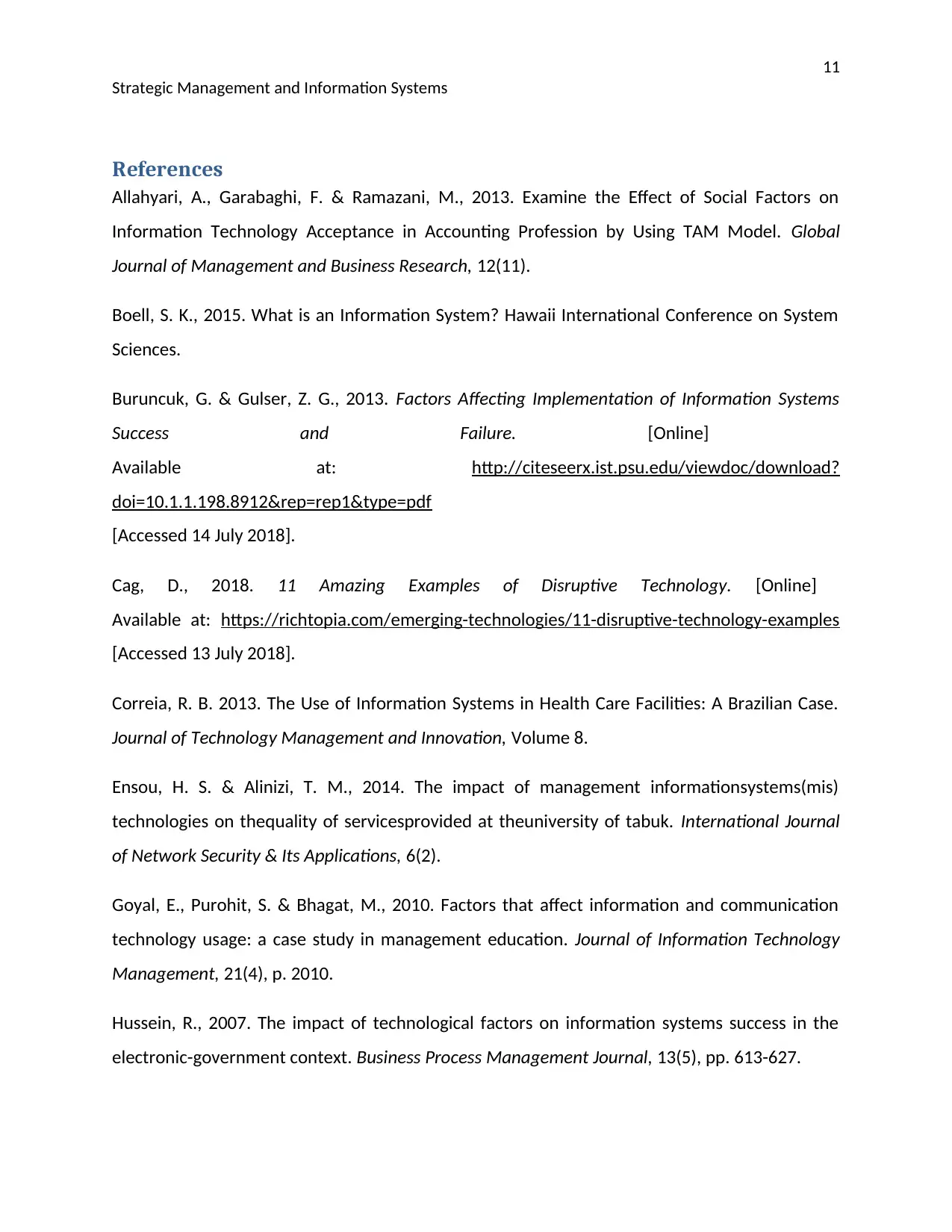
11
Strategic Management and Information Systems
References
Allahyari, A., Garabaghi, F. & Ramazani, M., 2013. Examine the Effect of Social Factors on
Information Technology Acceptance in Accounting Profession by Using TAM Model. Global
Journal of Management and Business Research, 12(11).
Boell, S. K., 2015. What is an Information System? Hawaii International Conference on System
Sciences.
Buruncuk, G. & Gulser, Z. G., 2013. Factors Affecting Implementation of Information Systems
Success and Failure. [Online]
Available at: http://citeseerx.ist.psu.edu/viewdoc/download?
doi=10.1.1.198.8912&rep=rep1&type=pdf
[Accessed 14 July 2018].
Cag, D., 2018. 11 Amazing Examples of Disruptive Technology. [Online]
Available at: https://richtopia.com/emerging-technologies/11-disruptive-technology-examples
[Accessed 13 July 2018].
Correia, R. B. 2013. The Use of Information Systems in Health Care Facilities: A Brazilian Case.
Journal of Technology Management and Innovation, Volume 8.
Ensou, H. S. & Alinizi, T. M., 2014. The impact of management informationsystems(mis)
technologies on thequality of servicesprovided at theuniversity of tabuk. International Journal
of Network Security & Its Applications, 6(2).
Goyal, E., Purohit, S. & Bhagat, M., 2010. Factors that affect information and communication
technology usage: a case study in management education. Journal of Information Technology
Management, 21(4), p. 2010.
Hussein, R., 2007. The impact of technological factors on information systems success in the
electronic-government context. Business Process Management Journal, 13(5), pp. 613-627.
Strategic Management and Information Systems
References
Allahyari, A., Garabaghi, F. & Ramazani, M., 2013. Examine the Effect of Social Factors on
Information Technology Acceptance in Accounting Profession by Using TAM Model. Global
Journal of Management and Business Research, 12(11).
Boell, S. K., 2015. What is an Information System? Hawaii International Conference on System
Sciences.
Buruncuk, G. & Gulser, Z. G., 2013. Factors Affecting Implementation of Information Systems
Success and Failure. [Online]
Available at: http://citeseerx.ist.psu.edu/viewdoc/download?
doi=10.1.1.198.8912&rep=rep1&type=pdf
[Accessed 14 July 2018].
Cag, D., 2018. 11 Amazing Examples of Disruptive Technology. [Online]
Available at: https://richtopia.com/emerging-technologies/11-disruptive-technology-examples
[Accessed 13 July 2018].
Correia, R. B. 2013. The Use of Information Systems in Health Care Facilities: A Brazilian Case.
Journal of Technology Management and Innovation, Volume 8.
Ensou, H. S. & Alinizi, T. M., 2014. The impact of management informationsystems(mis)
technologies on thequality of servicesprovided at theuniversity of tabuk. International Journal
of Network Security & Its Applications, 6(2).
Goyal, E., Purohit, S. & Bhagat, M., 2010. Factors that affect information and communication
technology usage: a case study in management education. Journal of Information Technology
Management, 21(4), p. 2010.
Hussein, R., 2007. The impact of technological factors on information systems success in the
electronic-government context. Business Process Management Journal, 13(5), pp. 613-627.
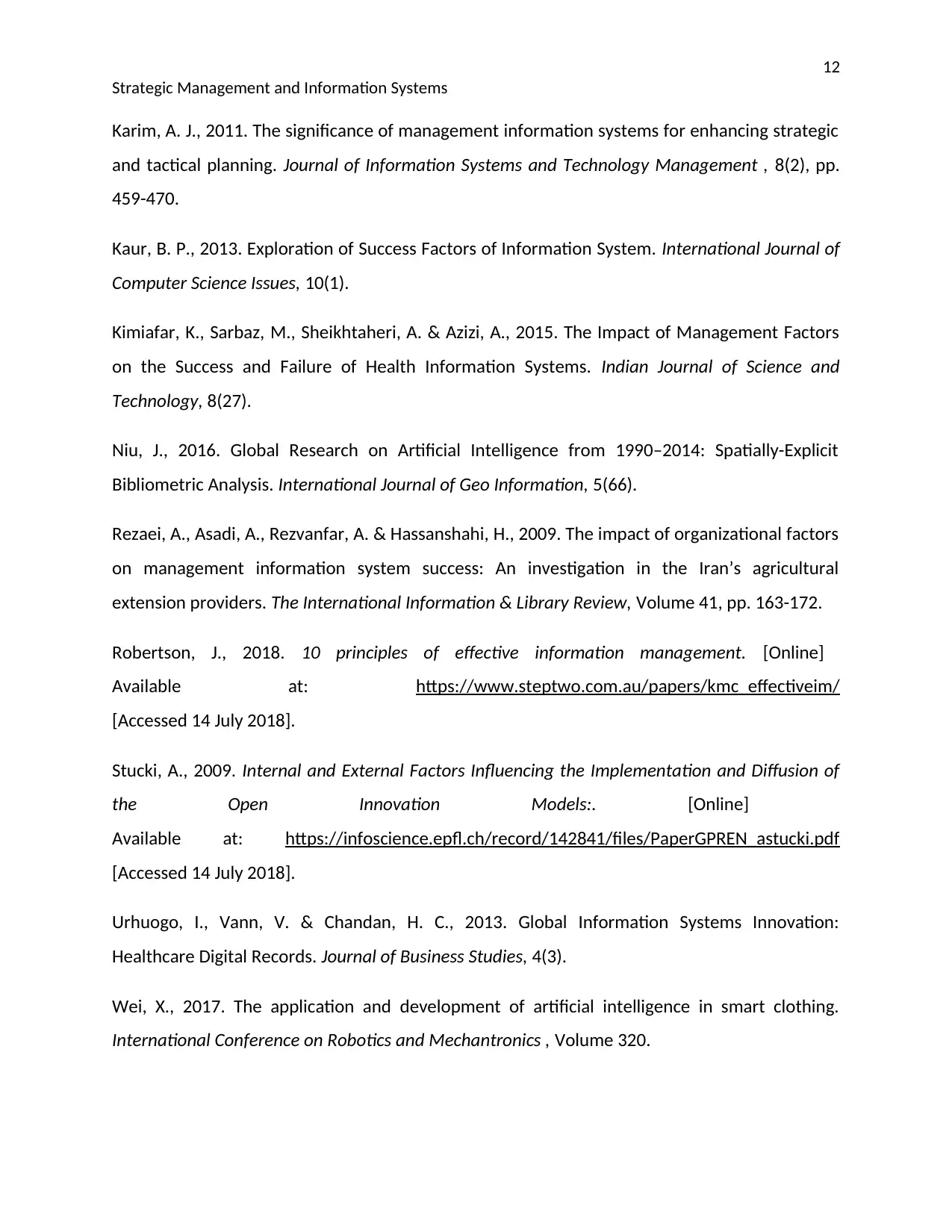
12
Strategic Management and Information Systems
Karim, A. J., 2011. The significance of management information systems for enhancing strategic
and tactical planning. Journal of Information Systems and Technology Management , 8(2), pp.
459-470.
Kaur, B. P., 2013. Exploration of Success Factors of Information System. International Journal of
Computer Science Issues, 10(1).
Kimiafar, K., Sarbaz, M., Sheikhtaheri, A. & Azizi, A., 2015. The Impact of Management Factors
on the Success and Failure of Health Information Systems. Indian Journal of Science and
Technology, 8(27).
Niu, J., 2016. Global Research on Artificial Intelligence from 1990–2014: Spatially-Explicit
Bibliometric Analysis. International Journal of Geo Information, 5(66).
Rezaei, A., Asadi, A., Rezvanfar, A. & Hassanshahi, H., 2009. The impact of organizational factors
on management information system success: An investigation in the Iran’s agricultural
extension providers. The International Information & Library Review, Volume 41, pp. 163-172.
Robertson, J., 2018. 10 principles of effective information management. [Online]
Available at: https://www.steptwo.com.au/papers/kmc_effectiveim/
[Accessed 14 July 2018].
Stucki, A., 2009. Internal and External Factors Influencing the Implementation and Diffusion of
the Open Innovation Models:. [Online]
Available at: https://infoscience.epfl.ch/record/142841/files/PaperGPREN_astucki.pdf
[Accessed 14 July 2018].
Urhuogo, I., Vann, V. & Chandan, H. C., 2013. Global Information Systems Innovation:
Healthcare Digital Records. Journal of Business Studies, 4(3).
Wei, X., 2017. The application and development of artificial intelligence in smart clothing.
International Conference on Robotics and Mechantronics , Volume 320.
Strategic Management and Information Systems
Karim, A. J., 2011. The significance of management information systems for enhancing strategic
and tactical planning. Journal of Information Systems and Technology Management , 8(2), pp.
459-470.
Kaur, B. P., 2013. Exploration of Success Factors of Information System. International Journal of
Computer Science Issues, 10(1).
Kimiafar, K., Sarbaz, M., Sheikhtaheri, A. & Azizi, A., 2015. The Impact of Management Factors
on the Success and Failure of Health Information Systems. Indian Journal of Science and
Technology, 8(27).
Niu, J., 2016. Global Research on Artificial Intelligence from 1990–2014: Spatially-Explicit
Bibliometric Analysis. International Journal of Geo Information, 5(66).
Rezaei, A., Asadi, A., Rezvanfar, A. & Hassanshahi, H., 2009. The impact of organizational factors
on management information system success: An investigation in the Iran’s agricultural
extension providers. The International Information & Library Review, Volume 41, pp. 163-172.
Robertson, J., 2018. 10 principles of effective information management. [Online]
Available at: https://www.steptwo.com.au/papers/kmc_effectiveim/
[Accessed 14 July 2018].
Stucki, A., 2009. Internal and External Factors Influencing the Implementation and Diffusion of
the Open Innovation Models:. [Online]
Available at: https://infoscience.epfl.ch/record/142841/files/PaperGPREN_astucki.pdf
[Accessed 14 July 2018].
Urhuogo, I., Vann, V. & Chandan, H. C., 2013. Global Information Systems Innovation:
Healthcare Digital Records. Journal of Business Studies, 4(3).
Wei, X., 2017. The application and development of artificial intelligence in smart clothing.
International Conference on Robotics and Mechantronics , Volume 320.
1 out of 13
Related Documents
Your All-in-One AI-Powered Toolkit for Academic Success.
+13062052269
info@desklib.com
Available 24*7 on WhatsApp / Email
![[object Object]](/_next/static/media/star-bottom.7253800d.svg)
Unlock your academic potential
© 2024 | Zucol Services PVT LTD | All rights reserved.





